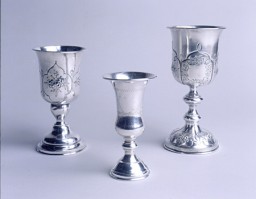
Artifact
Browse an alphabetical list of artifacts from the Holocaust and World War II. Each object tells a story about the history and demonstrates human experiences during the time period.
<< Previous | Displaying results 1-10 of 21 for "Artifact" | Next >>
-
Sandals
ArtifactWooden sandals worn by a member of the Mir Yeshiva in Shanghai. [From the USHMM special exhibition Flight and Rescue.]
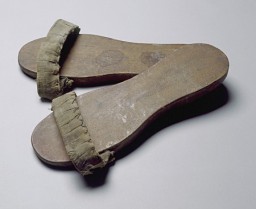
-
Scales used by refugees
ArtifactScale used by refugees Masza Swislocki and George Lieberfreund to weigh jars of artificial honey, which they manufactured and sold in the restricted area of Shanghai. [From the USHMM special exhibition Flight and Rescue.]
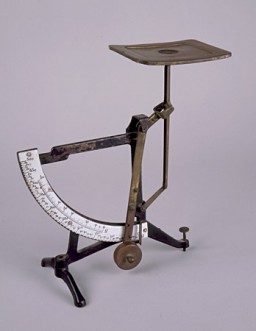
-
Scrapbook
ArtifactMany observers at the IMT, aware of the historic nature of the trial, created scrapbooks to preserve their own record of the Nuremberg court. First Lieutenant Herman E. Klappert, Jr. was a photographer with the U.S. Army Signal Corps who assembled three such scrapbooks. Klappert's albums consist almost entirely of photographs that he printed himself. Also included in the albums are original autographs from the defendants and other principal figures at the trial, official identification cards issued to…
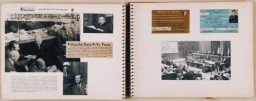
-
Scrapbook
ArtifactMany observers at the International Military Tribunal (IMT) at Nuremberg, aware of the historic nature of the trial, created scrapbooks to preserve their own record of the Nuremberg court. First Lieutenant Herman E. Klappert, Jr. was a photographer with the U.S. Army Signal Corps who assembled three such scrapbooks. Klappert's albums consist almost entirely of photographs that he printed himself. Also included in the albums are original autographs from the defendants and other principal figures at the…

-
Selma Engel diary entry about arrival in Sobibor
ArtifactDiaries reveal some of the most intimate, heart-wrenching accounts of the Holocaust. They record in real time the feelings of loss, fear, and, sometimes, hope of those facing extraordinary peril. Selma Wijnberg and Chaim Engel met and fell in love in the Sobibor killing center. After the young couple made a daring escape during the camp uprising and fled into hiding, Selma began a diary to record their experiences. The diary was written in 1943-1944 while Selma was in hiding in German-occupied Poland.…
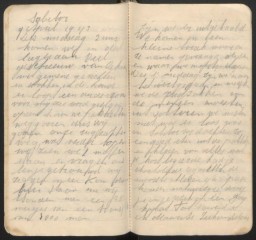
-
Selma Engel diary entry about escaping during the Sobibor uprising
ArtifactDiaries reveal some of the most intimate, heart-wrenching accounts of the Holocaust. They record in real time the feelings of loss, fear, and, sometimes, hope of those facing extraordinary peril. Selma Wijnberg and Chaim Engel met and fell in love in the Sobibor killing center. After the young couple made a daring escape during the camp uprising and fled into hiding, Selma began a diary to record their experiences. The diary was written in 1943-1944 while Selma was in hiding in German-occupied…
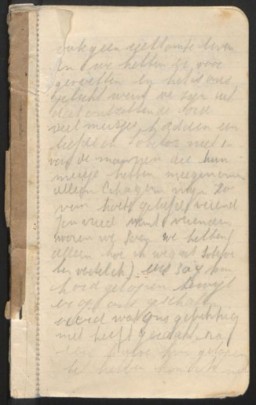
-
Selma Engel diary entry about life in hiding
ArtifactDiaries reveal some of the most intimate, heart-wrenching accounts of the Holocaust. They record in real time the feelings of loss, fear, and, sometimes, hope of those facing extraordinary peril. Selma Wijnberg and Chaim Engel met and fell in love in the Sobibor killing center. After the young couple made a daring escape during the camp uprising and fled into hiding, Selma began a diary to record their experiences. The diary was written in 1943-1944 while Selma was in hiding in German-occupied…

-
Sign excluding Jews from public places
ArtifactSigns excluding Jews, such as the sign shown here, were posted in public places (including parks, theaters, movie houses, and restaurants) throughout Nazi Germany. This sign states in German: "Jews are not wanted here."

-
Sign from Shanghai Ghetto
ArtifactOne of many signs displayed along the Shanghai ghetto's boundaries: "Stateless Refugees are Prohibited to Pass Here without Permission". This plaque was removed by a refugee at the end of the war. [From the USHMM special exhibition Flight and Rescue.]
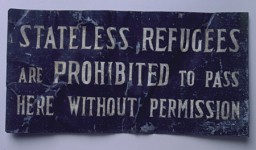
-
Silver kiddush cups of Caspary family
ArtifactGoblets used in Shanghai by the Caspary family for blessings (Kiddush) over wine on the Sabbath or Jewish holidays. The Orthodox Casparys ran a kosher restaurant frequented by yeshiva students from Poland. [From the USHMM special exhibition Flight and Rescue.]
